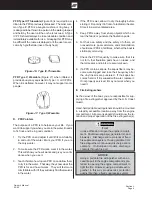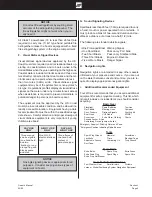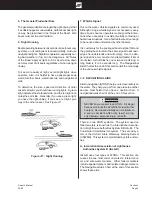
Owner’s Manual
05/00
Section H
Page 4
H. Inspection
Look and listen for leaks in the exhaust systems of both
the generator and propulsion engine(s). Look for dis-
coloration around joints in the system (water leaks, car-
bon, stains, etc.).
1.
Make sure all exhaust clamps are in place and se-
cured.
2.
Make sure ventilation systems work and are not ob-
structed or restricted
3.
Make sure gaps around the engine room plumbing
and cableways and exhaust system doors, hatches,
and access panels are minimized to reduce the op-
portunity for CO to enter the accommodation
spaces.
I.
Operation
Cold Start vs. Warm Start: CO production is greater
while the combustion chamber surfaces and gas pas-
sages are cold versus when they are warm. A boat
operator should:
1.
Pay attention to ventilating the boat,
2.
Orient the boat so it will allow the maximum dissi-
pation of CO,
3.
Minimize the time spent on getting underway.
The following are examples of possible situa-
tions where carbon monoxide can accumulate
within your boat while docked, anchored, or
underway. Become familiar with these ex-
amples and their precautions to prevent dan-
gerous accidents or death.
J.
Boathouses, Sea Walls and Other Boats
A boat operator should be aware that dangerous con-
centrations of CO can accumulate when a boat, gen-
erator or other engine operated device is operated while
the boat is moored in a confined area such as:
1.
Boathouses,
2.
Proximity to sea walls, or
3.
Proximity to other boats.
F.
Symptoms
One or more of the following symptoms can signal the
adverse effect of CO accumulation:
1.
Watering and itchy eyes
2.
Flushed appearance
3.
Throbbing temples
4.
Inattentiveness
5.
Inability to think coherently
6.
Ringing in the ears
7.
Tightness across the chest
8.
Headache
9.
Drowsiness
10. Incoherence
11. Nausea
12. Dizziness
13. Fatigue
14. Vomiting
15. Collapse
16. Convulsions
NOTICE
The order shown in the preceding list is gener-
ally the sequence of appearance of symptoms.
However, the order of appearance may change
for different people.
NOTICE
The symptoms of carbon monoxide poison-
ing may easily be mistaken for seasickness.
G. Treatment (Evacuate, Ventilate, Investigate, Take
Corrective Action)
1.
Move the person to fresh air.
2.
Administer oxygen if available.
3.
Always contact Medical help.
4.
If the victim is not breathing, perform artificial respi-
ration per approved CPR procedures until medical
help arrives and takes over.
NOTICE
Prompt action can make the difference between
life and death.
5.
Ventilate area.
6.
Investigate source of CO and take corrective action.
Summary of Contents for Horizon 200
Page 1: ......
Page 56: ...Owner s Manual 05 00 Section G Page 6 Figure G7 General Water System Diagram WATER SYSTEM ...
Page 80: ...Owner s Manual 05 00 Section J Page 15 Figure J16 Skiing Signals ...
Page 131: ...Owner s Manual 05 00 Fuel Log Page 1 FUEL LOG DATE HOURS RUN FUEL GAL RANGE MILES RPM MPH GPH ...
Page 132: ...Owner s Manual 05 00 Fuel Log Page 2 FUEL LOG DATE HOURS RUN FUEL GAL RANGE MILES RPM MPH GPH ...
Page 133: ...Owner s Manual 05 00 Fuel Log Page 3 FUEL LOG DATE HOURS RUN FUEL GAL RANGE MILES RPM MPH GPH ...
Page 134: ...Owner s Manual 05 00 Service Log Page 1 SERVICE LOG DATE HOURS MAINTENANCE PERFORMED ...
Page 135: ...Owner s Manual 05 00 Service Log Page 2 SERVICE LOG DATE HOURS MAINTENANCE PERFORMED ...
Page 136: ...Owner s Manual 05 00 Service Log Page 3 SERVICE LOG DATE HOURS MAINTENANCE PERFORMED ...
Page 138: ...Page 1 1998 1999 MODEL YEAR 200 HORIZON 245 SUNDOWNER Electrical Schematics ...
Page 140: ......






























